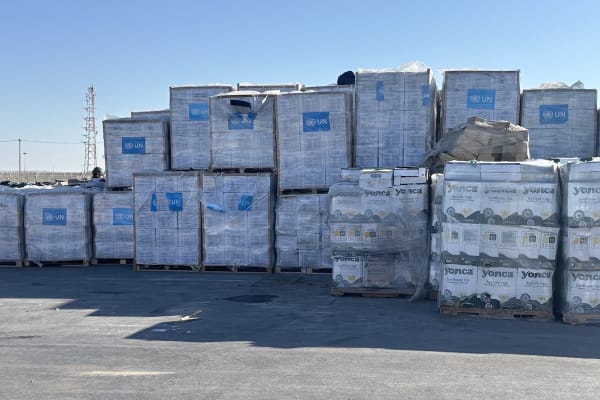The first step toward peace in Gaza is truth. But if what I saw on the Gaza side of the Kerem Shalom crossing is any indication, truth is in short supply – and few seem to care.
Last Wednesday afternoon, under the unrelenting glare of the Middle East sun, I was among a small group of journalists and influencers granted rare access to one of four entry points where humanitarian aid flows into the Gaza Strip. This aid is mainly funded by the international community and intended for the people of Gaza.
More than 60 countries – from Ireland and Russia to Italy and the United Arab Emirates – send assistance. It’s not just sacks of rice and canned goods. Pallets carry warm blankets, baby formula, clothing, toiletries, and much more, to help civilians in desperate need.
I didn’t know exactly what I would find at Kerem Shalom. But what I witnessed deserves to be shared – because it raises uncomfortable questions about who is really helping the people of Gaza, and who is merely pretending to.
First and foremost, the IDF soldiers I met at the crossing were efficient and effective in their work. They were well-organized, knowledgeable about the aid moving in and out, strong, and focused. Yet, they were also warm and approachable.
Like so many Israelis, they smiled and laughed easily. Some glanced curiously at the influencers in our group. They even clapped for a journalist who delivered a 4-minute stand-up report telling the truth to her viewers. “We love you,” one soldier said with a grin.
These were not harsh or unfeeling soldiers. They were young men and women doing their best for Israel and simultaneously for the people of Gaza.
For safety, we were required to wear protective vests and helmets – the bare minimum for entering the area. The helmets were heavy and stifling, making it difficult to move freely. The soldiers carried many more layers of protective gear, weapons, and other essential equipment.
But the real challenge was the heat. Summers in Israel are always intense, and the country is in the grip of a heatwave right now. These soldiers spend hours on their feet, moving and guarding the aid destined for the people of Gaza. They work long shifts under extreme conditions and face the constant risk of attack from terrorists or looters targeting the aid.
The danger is very real. In May of last year, four Israeli soldiers were killed in a Hamas rocket attack near the crossing, and several others were wounded.
Israeli officials stress that terrorist groups often target civilian infrastructure – like the crossings – that are vital to Palestinian welfare. They say such attacks not only endanger lives but also undermine any chance of stability or coexistence between Israelis and Palestinians by turning humanitarian lifelines into battlegrounds.
Of course, the most striking thing we saw at the crossing was the sheer volume of aid – literally tons – earmarked for the people of Gaza.
It’s important to understand that Israel’s role is to allow aid into Gaza. Currently, there are several crossings or checkpoints through which this aid passes . While the assistance has been entering for months, the NGOs responsible have not efficiently collected or distributed it to the people.
On Wednesday, the IDF told us that much of the food and supplies had been under the blistering sun for days, sometimes weeks. Many boxes were still scattered on the ground or rotting in their packaging. Some had been opened, the thick desert dust coating the goods inside.
Wasted humanitarian aid for Gaza at Kerem Shalom crossing (Photo: Maayan Hoffman)
Kerem Shalom is heavily secured with multiple layers of fencing and fortifications. The goods inside are under Israel’s protection. Still, I expected to see trucks lined up, ready to ferry supplies to Gaza’s civilians. Instead, few trucks were in sight, and the aid was strewn along the roadside.
Rows upon rows of pallets stretched before us – everything from canned tuna to diapers. The NGOs and humanitarian organizations responsible for moving the goods have argued that it’s been too dangerous to collect and deliver them, even after Israel implemented secure corridors. Even when Israel arranged trucks for deliveries, it often took these organizations several days to organize pickups once new aid arrived.
The United Nations itself has admitted that almost 9 out of 10 aid trucks are intercepted before reaching their destinations – either by armed Hamas operatives or angry and hungry Gazans.
Israel has not been free of responsibility. In March, following a temporary ceasefire, Israel imposed a blockade on Gaza that halted all aid. This decision delayed relief, worsening an already desperate situation.
In recent weeks, under mounting pressure and as it prepares for the final phase of the war, Israel has completely overhauled its policies.
By the end of July, the IDF had begun implementing daily, localized tactical pauses in specific areas of Gaza where the military is not active to facilitate humanitarian efforts.
In addition, secure corridors have been designated for most of the day to allow the safe movement of UN and NGO convoys delivering food and medicine across the strip. The IDF has also been air-dropping food into Gaza.
“The State of Israel doesn’t limit the trucks of aid coming to the Gaza Strip,” stressed Col. Abdullah Halabi, head of the Coordination and Liaison Administration for Gaza, in a statement. “The main issue – the main problem – is the collection and distribution. We encourage our friends and colleagues from the international community to collect the aid and deliver it.”
Me standing in front of humanitarian aid for Gaza at Kerem Shalom crossing
An IDF spokesperson told ALL ISRAEL NEWS on Wednesday that for weeks, only a few hundred trucks were moving aid from Kerem Shalom into Gaza each week. In the last two weeks, that number has more than tripled, exceeding 1,000 trucks.
According to COGAT, more than 1.8 million tons of aid have entered the Strip since the start of the war, delivered by over 96,000 trucks, and via the air and sea.
It should be stressed that Israel – unlike any other country in the world – has been required to supply its enemy. This is unprecedented. Dr. Adi Schwartz of the Misgav Institute said in a June interview that Israel has been held to a different standard than other nations, forced to provide food, water, and electricity to a territory controlled by a terrorist organization, thereby inadvertently sustaining Hamas.
“I have never heard of an army or a country that is trying to win a war and at the same time providing these supplies to the enemy,” Schwartz said.
Last week, Finance Minister Bezalel Smotrich told KAN News that NIS 3 billion ($876 million) would be allocated for humanitarian aid to Gaza’s civilian population. He said the goal was to “win the war,” adding that if Israel had controlled the flow of humanitarian aid into Gaza earlier, “we would have won the war a while ago.”
Smotrich explained that the funds would be available, if needed, to support the American-run Gaza Humanitarian Foundation and to establish aid distribution centers, so that “this horrific and dismal foolishness that we see now –in which the trucks are going straight to Hamas – will cease.”
Meanwhile, Israel is preparing for a complete military occupation of Gaza , including the remaining 25% of territory where the army has not yet operated, to bring the hostages home and end the war. Hamas is once again claiming it will agree to a ceasefire, but in recent months, every agreement that seemed close to being signed was ultimately rejected by the terror group.
Many analysts believe the reason ties directly to the issue at hand: truth.
Hamas has been emboldened by international support for its false narrative that there is a famine in Gaza. The reality is different.
There is hunger, but not famine.
There is a shortage of food reaching civilians, but not because of Israel.
As the Kerem Shalom crossing shows clearly, the bottleneck lies in Hamas’ grip over aid and the chaos it fosters.
If the world truly wants to see Gazans fed, it must first see Hamas removed from power. Because it is not Israel starving Gaza, it is the terror organization – and the lies it spreads and the international community repeats – that are depriving civilians of the aid waiting just meters away.
We see scenes like this each day: Palestinians expressing gratitude to America and @POTUS for lifesaving aid.
In just two months, we’ve delivered over 98 million meals to the people of Gaza.
We are proud to be part of this vital mission, and we urge the international community… pic.twitter.com/dAENT5GBx8
— Gaza Humanitarian Foundation (@GHFUpdates) July 30, 2025
Is ALL ISRAEL NEWS’ faithful reporting important to you? Be part of it – help us continue by becoming a $5/month supporting partner .





